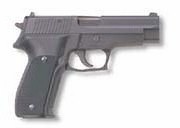 SigSauer P226
SigSauer P226firearms.txt
Quick Note
Make no mistake, your line of work is dangerous. It now doubly so because of the nature of the threat you are dealing with. The unknown dangers you face are often lethal and disturbing. Many federal agents are issued firearms for their self defense should they need them during the course of their duties. However, several points should be raised about firearms because of the new threats you face.
Legal Issues
As you all know, you are only legally allowed to draw your firearm and use it in situations where you have a clear danger being issued to your person or an innocent 3rd party. Without a legitimate reason, you will be prosecuted for negligence as well as sued by the victim of your actions. However, you are also presented with the greatest responsibility of protecting yourself and those around you. There is simply no room for error in this topic. Life and death is at stake. Your status as agents for Delta Green only serve to further complicate this issue. Your actions are often illegal, and will involve the destruction of government property, assault, murder, obstruction of justice, and destruction of evidence. It is imperative that you maintain a low profile and cover your tracks.
The Purpose of Your Firearm
The FBI has written a superb memo about this subject. In the event you are required to use your firearm, it is because your life or someone else's is in danger. Because you may not legally use your firearm until that moment, time is very short. You may be able to count upon one shot, and sometimes not even that, before your assailant begins his or her attack. For that reason, it is imperative that this one shot counts. That one shot must immediately incapacitate the assailant, and considering you will be firing from less than optimum conditions, it will be difficult. And that is exactly why your choice of firearm is an extremely important decision. Your life is on the line, and even though all firearms kill, you will want one that presents you with the greatest chance of survival. A decade of forensic research has concluded that a firearm must penetrate at least 12" of human flesh in order to be considered effective enough for use by federal agents.
Operation
All modern firearms use cartridges. A cartridge is a metal cylinder that contains the gunpowder, the bullet, & primer. The primer is ignited by a small but significant force to the back of the cartridge (usually the gun's hammer, which is released by pulling the trigger). The primer then lets off enough heat to ignite the main body of gunpowder. This huge expansion (or explosion) of gas accelerates the bullet out of the cartridge, down the barrel, and out the gun at tremendous speeds, well over 1200 feet per second (and then, hopefully into the target). The recoil generated by the expansion of the gas is used to push several mechanisms such that the empty cartridge is ejected and a fresh cartridge is pushed into place. Most modern firearms operate on this principle.
Caliber
Cartridges have come in various sizes over the year. They differ in Length, and Caliber. A gun will only fire a cartridge of a certain length and caliber. As it is, pistols use the shortest cartridges, with revolvers using longer ones, and rifles finally using the longest. Note that the longer the cartridge, the most gunpowder is packed into it. Hence, a longer cartridge is usually the more powerful one. This is not always true however, due to bullet mass, barrel length, etc. Caliber is usually denoted as a decimal. Examples include .357 and .45 which denote the cartridges diameter in inches. Cartridges such as 9mm, 5.56mm and 7.62mm merely denote their diameter in metric units. A cartridge name may include length as well, such as 9 x 19mm, 5.56 x 45mm. Note that while a handgun, revolver, and rifle cartridge may have the caliber (such as .357), they are different cartridges because the rifle's is longer than the revolver's, which is longer than the handgun's. Cartridges used with handguns are always shorter than their rifle or revolver counterparts.
Currently Used Firearms
Over the years, the various agencies of our nation have switched from standard issue firearm to firearm. Not all agencies hand out the same gun, and often you are given the choice of picking your own. Below are a list of the most common standard issue firearms that have a record of effectively protecting those who wielded them. The reasons are given below, but perhaps the most striking reason is the survival rate of those who carry them.
 SigSauer P226
SigSauer P226
This handgun is perhaps the most effective and innovative semi-automatic pistol currently in production. It can fire 3 different calibers of cartridge with only a minute long switch of the barrel. In addition, it's innovative design combined with recent cartridge technology allows it to fire .357 SIG rounds, which are far more powerful than the .45 caliber rounds, with less recoil. The .357 SIG round packs all the power and accuracy of a .357 Magnum revolver round with the minimum recoil of a 9mm round. It is standard issue for the FBI, and several agencies are also adopting it for widespread use. It's magazine carries 15 9mm rounds, 13 .40 S&W rounds, or 12 extremely powerful .357 SIG rounds.
| Caliber | Rate of Fire | Magazine | Damage | Malfunction |
| 9mm | 2 | 15 | 1d10 | 99-98-90 |
| .40 S&W | 2 | 13 | 1d10+1 | 99-98-90 |
| .357 SIG | 2 | 12 | 1d8+1d4+1 | 99-98-90 |
(Image from www.sigarms.com, official web site of Sig Arms Inc.)
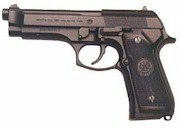 Beretta M92
Beretta M92
This handgun has become the sidearm of many U.S. special forces soldiers (such as the US Rangers in Operation RESTORE HOPE) as well as various other agencies within the armed forces. It has distinguished itself as highly reliable even in the most adverse of conditions. It replaced the Colt M1911A1 in some areas due to its larger magazine size, and nearly identical power. It uses a 9mm round, and can carry 15 rounds in its magazine.
| Caliber | Rate of Fire | Magazine | Damage | Malfunction |
| 9mm | 2 | 15 | 1d10 | 00-00-96 |
(Image from www.beretta.com, official web site of Beretta Firearms Inc.)
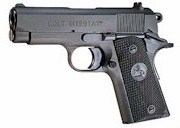 Colt M1911A1
Colt M1911A1
Originally designed in 1911 (hence its name), the Colt M1911A1 has changed only once since it's introduction in 1911. It uses a powerful .45 caliber round, which while powerful, also packs considerable recoil, increasing the time needed to steady the gun, and fire again. It is issued to weapon crews and as a sidearm for air force pilots. This gun is slower and weaker than a SigSauer P226 firing .357 SIG rounds, but for a gun design that is almost a century old, it performs amazingly well. It carries 7 .45 ACP caliber rounds in its magazine.
| Caliber | Rate of Fire | Magazine | Damage | Malfunction |
| .45 ACP | 1 | 7 | 1d10+2 | 99-98-90 |
(Image from www.colt.com, official web site of Colt Manufacturing Inc.)
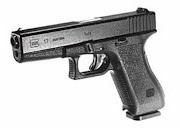 Glock 17
Glock 17
Many other federal agencies give their agents this pistol. Firing 9mm rounds, this pistol is known for being light weight, reliable, and having a huge 17 round capacity in it's magazine. Like the Beretta M92, this weapon is highly reliable, being able to fire underwater, and even when packed with sand. There have been security concerns over its polymer frame, but these have been found unsubstantiated. It only has recently been supplanted by the SigSauer P226 due to the P226's powerful .357 SIG firing ability.
| Caliber | Rate of Fire | Magazine | Damage | Malfunction |
| 9mm | 2 | 17 | 1d10 | 99-98-90 |
(Image from various unofficial FAQ's as the official Glock Inc. web site is under construction)
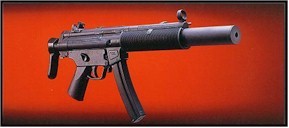 Heckler & Koch MP5 SSD sub-machine gun
Heckler & Koch MP5 SSD sub-machine gun
This submachine gun is almost used by every paramilitary unit nationwide, from the Navy SEALS, to the FBI Hostage Crisis team, to SWAT teams nationwide. It can fire single shots, 3 round bursts, or full auto bursts. Various models can fire either 9mm, 10mm, or .40 caliber S&W rounds. This versatility and a 30 round magazine, combined with an integral silencer make it an all around favorite when you have to pull out a big gun. However, legally, there is no reason for you to use or possess this weapon unless you are participating in a known situation that involves other heavy weapons. You will be denied access to these weapons by your superiors unless sufficient evidence of their need is presented.
| Caliber | Rate of Fire | Magazine | Damage | Malfunction |
| 9mm | 2, 3 burst, 20 burst | 15 or 30 | 1d10 | 98-96-75 |
| 10mm | 2, 3 burst, 20 burst | 15 or 30 | 1d10+1 | 98-96-75 |
| .40 S&W | 2, 3 burst, 20 burst | 15 or 30 | 1d10+1 | 98-96-75 |
(Image from http://mercury.2kweb.net/cqb/airguns.htm, CDQ Airsoft Airguns. This image does not show a real firearm)
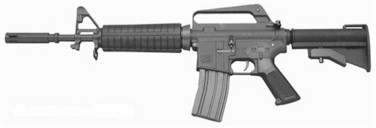 Colt M16A2 assault rifle and M4A2 carbine
Colt M16A2 assault rifle and M4A2 carbine
The M16 & M4 are in use with the US army. They both fire 5.56 x 45mm NATO standard rounds. The M16A4 has eventually developed a reputation for being one of the most reliable rifles in the world. Despite its abysmal performance in Vietnam as the M16, further modifications with the M16A1 and M16A2 have eliminated the jams, misfires, and clogging of the barrel. With a 20 or 30 round magazine, the M16A4 is a cheap and powerful rifle that is being utilized worldwide. The M4 carbine was developed due to the need for M16 firepower in close quarters and confined environments, leading to the M4A2 with a shorter barrel and additional options (flash suppressor, silencer). Like the H&K MP5 SSD sub-machine gun, the possession of this weapon is a federal offense. Unless you have exceptional reason to possess one, you will not be issued one. Only active members of the military are allowed to use this weapon, and only under the orders of their superior officers.
| Caliber | Rate of Fire | Magazine | Damage | Malfunction |
| 5.56 x 45mm NATO | 1 or 3 burst | 20 or 30 | 2d6+2 | 99-98-85 |
(M4 Image from http://shoga.wwa.com/~dvelleux/m16rifle.html, this image's authenticity is unknown)
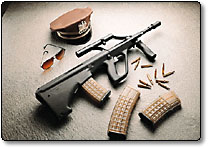 Steyr Mannlicher AUG-P assault rifle
Steyr Mannlicher AUG-P assault rifle
Only recently designed
and utilized, the Steyr AUG-P is one of the most modern and advanced assault rifles in the world.
There are 2 versions, one which fires the 5.56 x 45mm NATO standard round, the other the
less powerful 9 x 19mm handgun round that is standard world wide. It has a bull pup design
in which the magazine is put behind the hand grip, allowing for a longer barrel length.
This increased length adds not only to the power of the round (increased acceleration
time), but also increased accuracy. Combined with built in optical sights, the Steyr AUG
is both an assault and sniper rifle. Using a huge 42 round magazine, the Steyr AUG is advertised as the assault rifle of the future. 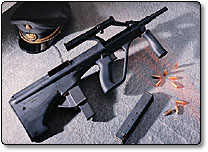
| Caliber | Rate of Fire | Magazine | Damage | Malfunction |
| 5.56 x 45mm NATO | 1, 3 burst, 20 burst | 30 or 42 | 2d6+2 | 99-98-90 |
| 9mm | 1, 3 burst, 20 burst | 30 or 42 | 1d10+1 | 99-98-90 |
(These images from www.steyr-mannlicher.com, the official Steyr Mannlicher Firearms web page)
Note: The above statistics are all different from the Delta Green sourcebook. They reflect what I believe to be a more accurate & balanced system based on research from the companies themselves, medical universities, and forensic labs. Below is a chart of revised caliber damages.
| Caliber | Old Damage | New Damage |
| .357 Magnum | 1d8+1d4 | 1d8+1d4+1 |
| .40 S&W | 1d10 | 1d10+1 |
| 5.56 x 45mm NATO | 2d6 | 2d6+2 |